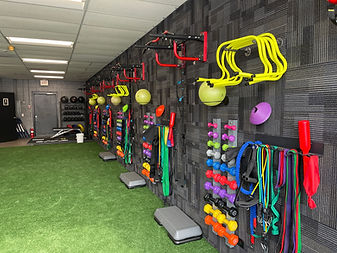Sports focused physical therapy & performance training in Algonquin, IL
What We Treat
Shoulder Pain
OTHER AILMENTS
Shoulder Pain Relief
The shoulder is one of the most dynamic joints in the body. The ball and socket joint affords a large range of motion, but with that comes the possibility of pain and discomfort. Shoulder pain can come from a sudden injury or trauma; such as during a football game or a fall onto the shoulder. Repetitive motion can also cause shoulder pain; such as with overhead sports like baseball, softball, and tennis, or during household or work duties. Poor posture and lifting mechanics can contribute to dysfunction. The type of pain you feel in your shoulder can vary from a dull ache to a shooting pain, depending on what is causing your pain. It can interfere with raising your arm to comb your hair, reaching behind your back to get your wallet out, or just being able to sleep on that side.
What is causing my Shoulder Pain?
Rotator Cuff Tendonitis – when the shoulder is excessively overused or muscles are imbalanced, tendonitis can occur. This can be due to overhead sports or labor-intensive activities. Tendons become swollen and inflamed and can result in pain when reaching. Often the shoulder becomes stiff with movement and weak with activities. Chronic tendonitis can lead to rotator cuff tearing and the need for surgery.
Impingement/Bursitis – a condition that develops when the bursa (a small fluid filled sac) or tendons become pinched at the shoulder joint. It is often caused by repetitive overhead work; either in sports such as tennis, baseball, and swimming, or in occupations which involve frequent reaching such as electricians or heavy lifting. Impingement or bursitis can cause a dull ache in the shoulder and may progress to sharper pain with certain movements. Loss of motion and weakness is common.
Shoulder Strains and Sprains - both sprains and strains are the result of the stretching of tissue beyond its capacity. A sprain involves a ligament while a strain refers to damage of a muscle or tendon. Strains and sprains can vary from mild to severe in nature; severe cases can result in a tear. Moderate to severe strains/sprains result in more pain, loss of motion/stiffness, and weakness.
Shoulder Dislocation/Subluxation – when the head of the humerus pops out of place, it is known as a dislocation. This can result from a high impact force such as a collision or a fall on an outstretched arm. Shoulder dislocations are extremely painful and often require rest/bracing to promote healing. Unfortunately, it is something you can become more vulnerable to after the first dislocation occurs. Instability can develop gradually over years from repetitive use that stretches the ligaments and creates increased laxity (looseness). If the rotator cuff is not able to control the laxity, then the shoulder will slip slightly off-center (subluxation) during movement.
SLAP Tear - SLAP is an acronym for superior labrum anterior and posterior. The labrum is a small piece of cartilage that lines the shoulder socket. In a SLAP injury, the top or superior part of the labrum is injured. Typically, symptoms can cause a catching or locking sensation to occur in the shoulder and pain with certain movements. A SLAP tear can occur with repetitive overhead motion, a sudden trauma, or degenerative changes. Sometimes, surgery is needed to repair or remove the damaged tissue.
Biceps Tendonitis/Tenosynovitis – biceps pain is most commonly located in the front of the shoulder and can radiate to the elbow. Often it is a dull ache, but may include popping and clicking. Pain is worsened with pushing/pulling, lifting, or doing repeated overhead activities. Muscle imbalance and weakness in the rotator cuff is often a contributing factor to biceps pain. Tendonitis can develop at top of the shoulder or near the elbow.
Little League Shoulder - is an overuse injury caused by stress to the arm bone (humerus) nearest to the shoulder. This stress causes widening of the growth plate, resulting in swelling and pain at the shoulder. It most commonly occurs in youth pitchers between ages 11 and 16.
Frozen Shoulder – also called adhesive capsulitis, causes pain and stiffness in the shoulder. Over time, the shoulder becomes very hard to move. After a period of worsening symptoms, frozen shoulder tends to get better, although full recovery can take many months.
Physical therapy is an easy, comfortable, and natural way to find relief for shoulder pain, without the need for harmful drugs, injections, or invasive surgery. Our experienced physical therapists are movement experts with advanced training who can help you get on the path to recovery. With our physical therapy treatments, you may find improvement and relief after just a few short sessions!
Our physical therapists are trained to pinpoint the cause of your pain through a variety of diagnostic testing techniques. Once we have established the root cause of your shoulder pain, we can create a specialized combination of physical therapy treatments to manage and relieve your pain symptoms. This may also include specialized treatments to address loss of motion and stiffness; such as ASTYM, manual therapy, and mobility work. A strengthening program is a must to correct imbalances, stabilize a shoulder, or prepare the body for return to athletic competition. Our athletes will benefit from use of our unique plyometric wall and sports specific training.
Don’t let your shoulder pain limit your physical abilities any longer! Get shoulder pain relief with physical therapy. Athletic Edge and Wellness with help you MOVE BETTER, PERFROM BETTER, and BE BETTER. Contact our Algonquin, IL office at 224-505-3343 today to schedule your appointment and get started on your path towards recovery.

Contact Athletic Edge and Wellness for Shoulder Pain Relief
Set up an Appointment Today!







